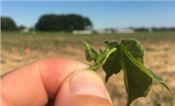Managing A Late Cotton Crop

DR. TYSON RAPER
JACKSON, TENN.
In the past 10 days, the TN cotton crop appears to have turned the corner. Still, most all our acres classify as ‘late’, with the majority of the crop planted after the 15th of May. That in itself isn’t too troubling, but the failure of late May and early June to provide any decent growing conditions delayed our crop even more. A long fall would correct most all issues, but I’ve not had much luck slowing time or changing the weather. Fortunately, we can take a few management strategies in the coming weeks to partially mitigate our painfully slow start to this season. In this blog, I highlight management decisions in three areas that can help us emphasize earliness- fertility, plant growth and plant bugs.
We are less than two weeks away from the 4th with only scattered squares. Still, somehow, cotton appears to come pre-programmed with the knowledge of calendar date and has the ability to close a maturity gap, if given a reasonable opportunity. And again, a long, hot fall could erase any yield penalty we might now think we have, based on our slow start. Still, given the cards in-hand, there are several management decisions that I believe will help us emphasize earliness and subsequently increase our chances of getting into the black.
First, fertility- nitrogen (N), potassium (K) and sulfur (S). I recognize that this choice has already been made for some, but for those that have yet to apply all of their N, consider slightly dropping N rate. An aggressive N application (100-120lb N/ac) will spur vegetative growth, push first fruiting node up the plant, decrease retention of fruit low on the plant, decrease the efficacy of our insecticides – all culminating into a substantial delay in maturity. In a late crop, these responses are magnified. Based on countless years of data, we need 80-90 lb N in a normal year to maximize yields. This year, I’d consider sliding N rate down to 60-80 lb. Make sure K has been properly applied based on soil test results.
You may still have a little time to correct low soil K, so long as we continue to receive rainfall. Finally, S must be in the mix, with the preferred source being ammonium sulfate.
Second, plant growth regulators (PGRs). Last year, many came out with stiff rates early in order to combat an environment that we expected would support excessive plant growth. In hindsight, we were often too heavy handed; the forecast included rains that didn’t develop. As a result, many acres never really lapped. Fortunately, the relationship between yield and plant height is relatively poor unless you get into very short or very tall cotton. As we consider how best to push earliness in this crop, I would start by gradually introducing multiple, low rate PGR applications. Many of the varieties we planted this year are fairly new, so we don’t have a tremendous amount of experience in how they will respond to PGRs in variable environments.
Slowly introducing multiple, low-rate PGR applications beginning pre- bloom while monitoring internode length between the fourth and fifth nodes will be the best way to prevent excessive vegetative growth and slowly transition the plant towards a reproductive focus. Keep in mind rank cotton usually sets fruit higher on the plant. In a normal year, fruit higher on the plant may have an opportunity to mature, but with our late start, we may not have that luxury. In a short-season environment, my plant growth management strategy is a little more aggressive than in a normal year.
Finally, plant bugs. I had the opportunity this morning to discuss best management practices to push earliness with Dr. Scott Stewart, and he emphasized two main points. First, timeliness; after reaching threshold, we need to act quickly. Allowing a threshold plant bug population to feed for several days before making an insecticide application could hurt more this year than in a normal crop. Second, make sure you aren’t cutting corners on products and rates. Dr. Stewart provided data on response to a variety of products and rates in his Cotton Focus video on plant bugs – you can watch that video by clicking here. Reach past the cheaper, less effective options this year for the ‘top shelf’ products and don’t get caught cutting corners on rates. And the question on everyone’s mind – should the established thresholds be reduced in a late crop? Not so, says Dr. Stewart. Reducing thresholds will increase costs and potentially flare other pests without increasing returns. Take home – act quickly when needed and use established thresholds with the right products and rates. More on that topic to come next week.
We’ve tackled three main issues – slight reductions in N rate, slightly-more aggressive plant growth management, and proper maintenance of plant bug thresholds. When boiled down, the focus of each of these approaches is setting and retaining first position fruit low on the plant. If we can execute each of these management activities, I believe we will be in a decent position regardless of what September may hold. ∆
DR. TYSON RAPER: Cotton & Small Grains Specialist, University of Tennessee